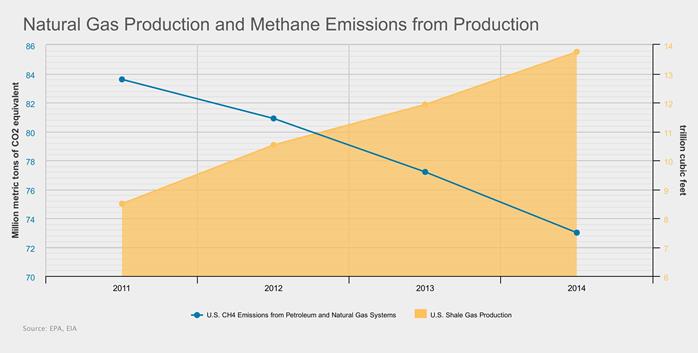Regulators Gonna Regulate – Methane Edition
Mark Green
Posted December 4, 2015
Part of the U.S. success in reducing greenhouse gas emissions is the significant drop in emissions of methane, the primary component in natural gas, from development operations. Since 2005, methane emissions from hydraulically fractured natural gas wells have plummeted 79 percent – with technology and innovation allowing industry to capture more of a product that can be delivered to consumers. This has occurred even as U.S. natural gas production has steadily climbed, thanks to shale, safe fracking and horizontal drilling:

It’s a shining chapter in a success story that shows how free market forces have taken the lead in reducing greenhouse gas emissions in this country. In turn, the U.S. is leading the world in reducing GHG emissions.
No matter. Despite these advances, EPA is proposing additional methane regulations on oil and gas wells and transmission. Unfortunately, more regulation could mean less – less fracking, less energy and, quite possibly, less progress in reducing emissions. API’s Howard Feldman, senior director of regulatory and scientific affairs, briefed reporters as industry was prepared to submit official comments on EPA’s rule proposal:
“EPA’s proposal for additional methane regulations on oil and gas wells and transmission are duplicative and costly. They could also undermine the progress our industry has made lowering greenhouse gas emissions.”
Feldman said emissions will keep falling as operators continue innovating and capturing a marketable product. This industry was doing before earlier layers of regulation on natural gas development went into effect. Feldman:
“The vast majority of reductions have been incurred even before the rules became effective. So when you look at the timeline of when the EPA data shows emissions reductions, you can see that we were making significant progress without EPA regulation. … We have been out there as leaders.”
He said new regulations are unnecessary and could be counterproductive – with the potential to discourage hydraulic fracturing while chilling the U.S. energy renaissance, economic growth and “our incredible progress reducing greenhouse gas emissions.”
Feldman said to justify an additional layer of methane regulation, EPA applied a social cost of methane, the estimate of which is “highly speculative and not sufficiently peer-reviewed.” He cited an independent review by NERA Economic Consulting that found flaws with EPA’s calculations. After compensating for these flaws, NERA’s review found that the rule’s benefits could be as much as 94 percent lower than EPA’s projection, he said. When combined with revised cost estimates and reduced emission benefits found in a separate study, the new EPA methane rules could result in net costs to society of more than $1 billion in 2025, he said.
All of the above generates a simple question: Why mess with success, EPA? Feldman:
“[T]he oil and gas industry is already leading the charge in reducing methane. The last thing we need is more duplicative and costly regulation that could increase the cost of energy for Americans and that could potentially drive up U.S. greenhouse gas emissions.”
About The Author
Mark Green joined API after a career in newspaper journalism, including 16 years as national editorial writer for The Oklahoman in the paper’s Washington bureau. Previously, Mark was a reporter, copy editor and sports editor at an assortment of newspapers. He earned his journalism degree from the University of Oklahoma and master’s in journalism and public affairs from American University. He and his wife Pamela have two grown children and six grandchildren.


